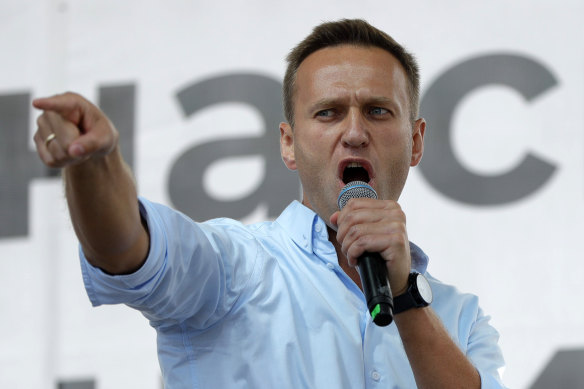
In retrospect, these moves appear to be part of Putin’s years-long preparations for invading Ukraine. By coming down so hard on the political opposition, he ensured there were few people willing to come out and protest against his criminal war, launched on February 24, 2022.
Almost two years into the war in Ukraine, Russian civil society has been decimated; almost every single prominent anti-Putin political figure and hundreds of thousands of anti-war Russians have fled abroad. The rare critics who have stayed, such as Ilya Yashin and Vladimir Kara-Murza, joined Navalny behind bars.

Alexei Navalny firing up a crowd during a political protest in Moscow in 2019.Credit: AP
The Kremlin does not have to fear protests in a country where a 72-year-old retired woman was sent to jail for five years last month, simply for an anti-war post on social media. Putin can torture, jail and kill the country’s most popular opposition politician safe in the knowledge that he is untouchable within Russia’s borders.
Outside of them, he does not fear the West. It took several months of the war in Ukraine before sanctions were imposed on Russia’s energy sector and oil exports in particular.
But the Russian economy is nowhere near the point of collapse; the Kremlin can still sell oil and gas on global markets, if not in Europe, and linchpins of the Russian export market such as the diamond trade have not been affected at all.
Loading
Meanwhile, the death of Navalny comes at a moment when the West is clearly getting tired of having to fund Ukraine’s military. Putin, for his part, is signalling that he would not mind freezing the frontline where it stands and calling it a victory.
If Putin was not being blamed for the death of Navalny, one could foresee US and European politicians following in the footsteps of Tucker Carlson and visiting him for talks in Moscow, sooner or later.
Whether Navalny died in an assassination or as a result of the torturous conditions he had been exposed to for three years, his death should put a halt to any such overtures – at least for now.









 Add Category
Add Category